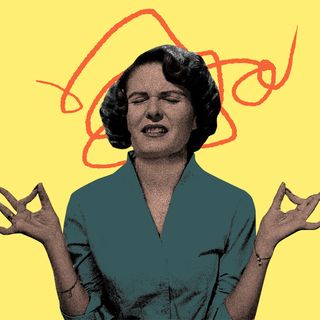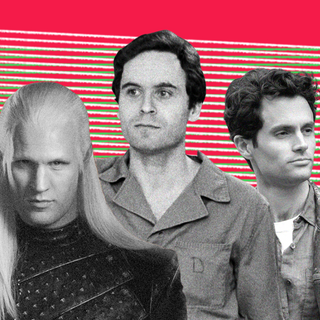
The Merits — and Demerits — of Side Character Energy
There’s something radical about the side character, who refuses to romanticize life and embraces the chaos instead.

In the history of internet culture, the summer of 2022 holds a distinguished space of defiance. No longer is there a pressing desire to play the protagonist of our lives; the promise of agency that theCarrie Bradshaws and Rory Gilmores of the world offered is neither as intriguing nor as worthy. Instead, the time is ripe for welcoming another energy —one that refuses any overarching meaning to our character journeys. This is the age of “side characters” — of people not fixated on being their “best versions, beaming with an aesthetic that is gorgeously accessible and attainable.
“I will not undergo any character development nor will I grow as a person. I’m here to be funny and sexy,” this was the official call to embrace the side-character energy from a TikToker who goes by the name of Lola. Lola asked for great outfits, funny one-liners, and a refusal to fixate on work and productivity. This version of life spoke to millions of people living in digital corners, who had grown weary of night-time routines and their five-page-a-day regimen. In July, writer Pema Bakshi called it the “season of the side character.”
The idea is that side character energy can liberate people from manufactured ways of finding control, but the flip side is also one of priming oneself into perpetual submission and self-neglect. The social media trend shares a tricky understanding in a culture where we measure people’s worth in extremes — someone is either a main character andworthy of all theattention, or their sidekick, who must do away with their personhood to make room for someone else’s. But the binary is flawed and restrictive. Understanding the purpose, or the lack of it, behind side characters, offers a new treatise that demands a rethink on how we think of the “self” in the first place.
It’s a departure from the “main character energy“vibe that the pandemic helped popularize; arguably, the loss of control and numbing stasis meant people turned to their digital selves to live the character arcs denied to them by reality. Life was now a movie, and people could plot out their desires and struggles with Lorde’s and Harry Styles’s music as the score of their lives. On them was a glossy spotlight, while their friends — the side characters — willingly agreed to take a backseat and fan their fears and fame. But we’re 31 months into the pandemic, and the consensus is unequivocal: character development is exhausting. As empowering as it is to position yourself as the protagonist of your life, it is incredibly exhausting too.
Contrast it with the unassuming energy of the side characters. “Characterized by being untroubled and brimming with witty rejoinders, traditional side characters tend to be the self-assured ones, the support characters who don’t need to engage in the dramatic character arcs because they’re perfectly content with their independence — not to mention they tend to make better choices because of their impartiality,” as Bakshi noted. A side character has little quarrelwith the world.
Arguably, the side character predates all internet cultures. Kim Cattrall in Sex and the City played an easy, self-assured Samantha next to Carrie’s self-centric ways. In movies more than one, Judy Greer played the best friend of the protagonist; so much so that side-character energy is synonymous with Jude Greer’s energy. In 27 Dresses, she was the wise side character to Katherine Heigl’s character who spends the entire 111 minutes falling out and falling in love with someone. Greer played similar versions in the likes of The Wedding Planner, Love Happens, andSuddenly 30, too — tucked in her classic 90s baguette bag was a refreshing, devil-may-care attitude. She was blasé about the trials and tribulations of love and career. More recently, we found a similar breeziness in Emily in Paris’s Mindy Chen; her Ashley is effervescent and elegantly navigates the identity flux of her character with passive ease.
Related on The Swaddle:
How the ‘Main Character’ Internet Trend Validates Our Need to Feel Seen
Side characters also encapsulate agency and spirited defiance. If the onus on the protagonist is to explore and discover themselves, the side character feels no such push. The energy is more of an aesthetic: picture a translucent summer-hued cocktail, an idle body content with its idleness, passively observing the world without feeling compelled to participate in it or find control. There is a choice present in the whole situation — an avenue that feels all the more tempting at a time when people have been denied any form of control.
These are all lovely things, but stepping away from the limelight is not an easy ask. Arguably, psychologists have warned of an unquestioned reliance on adopting the side-character energy, for it may trigger a cycle of self-neglect. If one is always giving space to others’ needs and desires, the emotional bandwidth to live one’s own life may slowly but surely deplete. It may result in a scenario where theyindulge in people pleasing, or worse, invest time in trying to “rescue“others “in order to feel needed, loved, or as if you have an important purpose to serve. In both cases, you’re likely to end up prioritizing other peoples’ issues or decisions over your own,” as Abby Rawlinson noted. If the pattern continues, chances are the side characters end up feeling more stressed and face a crisis of self-esteem when subjected to constant neglect.
But this demands a rethink of how we perceive side characters in the first place. These aren’t “supporting characters” or sidekicks; the Robins to someone’s Batman. Theyare complex, layered people who embody an energy that resists fitting any character arc, and the baggage that comes with it. And side and main characters aren’t mutually exclusive categories either; all side characters can be main characters on some days, and vice-versa. “There’s definitely a dance we do in healthy, balanced relationships where sometimes we step back and lift other people up,” Rawlinson added. “But when we need to, we’re still able to step forward into the spotlight.”
Judy Greer’s latest cinematic role comes in the form of Reboot, a satirical comedy where she is an unconventional protagonist, a fiery mix of both main and side characters.
Related on The Swaddle:
How the Pandemic Generation Became Disillusioned With the Coming‑of‑Age Genre
Arguably, this whole obsession with being characters reflects ananxiety about who we are and what part we play in this swirling world. We want agency around who we are and what stories we tell. This is where the side-character energy truly shines; rather than trivializing our problems and accepting life for what it is, being a side character implies an air of surety, owning up, and refreshing confidence.
There’s only something radical about embracing the life of the side character, for it pushes people to realize they are not as important in their life as they like to believe. In doing so, the side character energy eventually punctures the role of the hero, who isbogged down by the duty of finding themselves; in general, people in the limelight are associated with a form of self-absorption, entitlement, and even potential delusion. The side character doesn’t smile at the camera as much as they mock at it — because the narrative doesn’t revolve around them, it’s them who revolve around a larger, layered narrative.
In an interview, Chen aptly said: “Maybe it’s because we all are constantly trying to figure out who we are, I think that’s the whole point of this world. And if we’re able to, we try to help other people along that way, too, and find out who they are.”
Perhaps, that’s the point of the side character energy: It pushes us to ask what lies outside of the trappings of “development,” “growth,” and a relentless push to maximize your personality. What if you take a step back, and recalibrate the idea of “living” as one that constantly unfolds around you, and isn’t always necessarily about you?
“Letting go of the idea that your life needs to be worthy of a feature film to be worthwhile can liberate you to pursue the kind of life you actually want to live, rather than the one you think you should be living,” said Rawlinson. “With this energy, you can appreciate life’s more simple experiences, like the joy in being part of a community.” Life is inherently meant to be a site of chaos and confusion, and perhaps, the answer out of this maze is to not grasp for certainty, but to stop thinking of life in isolated terms of the “self” only, and allow oneself the luxury of exploring.
It makes room for a potentially radical question: Can you live without romanticizing your life?
Saumya Kalia is an Associate Editor at The Swaddle. Her journalism and writing explore issues of social justice, digital sub-cultures, media ecosystem, literature, and memory as they cut across socio-cultural periods. You can reach her at @Saumya_Kalia.
Related


Is This Normal? “I Hate Relaxing”
